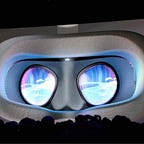Animoji = Avatar + Emoji. An Animoji is Volumetric Video + Neural Networks
Article written by Micah Blumberg for VRMA Virtual Reality Media
Today at Apple’s Special Event Apple unveiled the integration of some of the coolest new AR VR Volumetric and Artificial Intelligence technologies built in the next generation iPhone, to boot it comes with TRUE depth sensors. It is an incredibly exciting next step into our collective Augmented Reality and Virtual Reality future! Way to go Apple! You hit it out of the park by integrating all this amazing new technology into your latest products! Besides the new phone they also made many childhood dreams come true by integrating a cell phone into a watch meant for the masses.
A tiny bit of the future that was in a sense our prophecy delivered in comic books and in science fiction books, when we were growing up, when our parents were growing up, that has finally arrived. Apple revealed to the new Apple Watch to the world today. I think Apple Watch points to a future in which people have two gadgets, there watch, and their AR glasses. Why would you need a handheld phone when the world is effectively your screen?
Today we also learned that Ethan Hunt faces a Mission Impossible with Apple’s new Face ID that combines volumetric video with neural networks for security. Spy agencies everywhere are going to have to rethink their disguises now that Geometric Artificial Intelligence applied to Point Cloud Video can spot those disguises. How do we hack Apple Face ID? Can you make a 3D model of your face that can fool your phone? Sorry Tom Cruise (my favorite version of Ethan Hunt)
iPhone X has a true depth sensor, it records volumetric video of your face, creates a pointcloud, applies geometric neural networking science to ID you, and it can map your face to tiny avatars called animojis.
Apple Animoji is an Avatar plus an Emoji. It combines true depth sensors, volumetric video, point clouds turned into a 3D mesh, to map your real smile into the Animojis smile.
Apple has new specialized hardware built for a set of machine learning algorithms. They call it the A11 Bionic neural engine. It uses this hardware to drive neural networks that can recognize objects and faces, this is great for numerous AR Augmented Reality and VR Virtual Reality applications that are overlaid on top of the real world.
Apple’s new phone, the iPhone X, has a true depth sensor and hardware designed to run neural network math faster so it can recognize faces, this provides vastly improved device security, animated avatars that recognize your face expressions, and it does this by combining the hottest new technology including volumetric video, to make point clouds, and then 3D meshes, with geometric neural networking software, and all of this is great for AR and VR because that means better object recognition, and it means Animoji’s which is a new concept that combines the concept of an Avatar in VR with an Emoji and face tracking.
